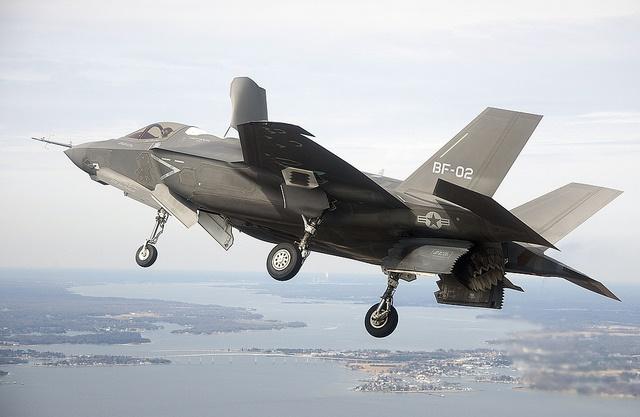LHD and F-35B: the debate opens up
Posted By Steve George on November 26, 2014 @ 06:00
 [1]Debate over the possibility of operating F-35B aircraft from the Canberra LHDs has opened up—a good thing. This post offers technical and tactical thoughts to stimulate the debate and challenge recent assertions.
[1]Debate over the possibility of operating F-35B aircraft from the Canberra LHDs has opened up—a good thing. This post offers technical and tactical thoughts to stimulate the debate and challenge recent assertions.
The feasibility of acquiring an F-35B/LHD capability is a key issue. Some assert that it’d be highly complex, take the ships out of service for long periods, cost $500 million, and require decades to achieve. Those assertions massively overstate the problems and ignore a plethora of inconvenient facts.
The Canberras retain the essential capability of the ‘Juan Carlos I’ design, including features that support the F-35B. They have air traffic control facilities for helicopter operations, which would support STOVL, although an additional lighting system may be required for bad weather operations. The F-35B wouldn’t require large ‘specialised’ maintenance facilities to be built into the ship, although adaptation of existing spaces might be required. The Canberras have enough fuel to support F-35Bs, and large weapons magazines. Claims to the contrary are incorrect.
Flight-deck heating issues are consistently overstated. Heat-resistant coatings might be required, but are easily applied. Other measures such as a ‘creeping’ vertical landing would further alleviate what’s already a minor issue.
The bottom line? Operating the F-35B from LHDs is technically feasible and well within the capability of the ADF. It wouldn’t be free, but nor would it break the bank.
Turning to strategic aspects, the laws of operational physics mean that the closer an aircraft is to target, the greater its effect. In many scenarios an LHD could get F-35s far closer to a theatre of operations than is possible by using far distant land bases. In many scenarios, it’d be the only option.
Some argue that land bases and overflight permissions will always be available. A recent ASPI paper states: ‘the ADF would reasonably expect to be able to operate land-based aircraft from the country whose on defensive efforts Australia would be supporting, or with whom we could come under common attack’ and ‘it’s prudent to assume that the [RAAF] would have access to land bases … to make a contribution to a future coalition air campaign’. Such statements must be challenged: unpredictable regional politics can, have and will trump ‘reasonable expectations’ and ‘prudent assumptions’. In fact, denial of host nation support happens frequently.
Malta denied use of its airfields in 2011 for the Libya campaign, and France, Spain and Italy all denied use of air-space for US air strikes on Libya in 1986. In both those cases, sea-based aircraft provided critical support to the campaigns. Recently, Turkey has refused use of its bases for strike aircraft—which the ASPI paper acknowledges but argues unconvincingly has been overcome by basing aircraft hundreds of miles further away in the UAE and Saudi Arabia. It surprisingly fails to mention that ship-based aircraft are executing a significant part of the air campaign. Again.
Withdrawal of host nation support leads to long-range operations and those have inherent limitations. Massive and expensive resources, particularly tankers and fuel, are required to generate relatively modest levels of ‘air’ over the distant target area. They also display the risky phenomenon of ‘scheduled war’, with air operations planned in detail over 48 hours in advance. The IS campaign shows that hands a useful advantage to enemy forces who can and do quickly change the situation on the ground.
An LHD/F-35B capability becomes even more important where the fight could threaten ADF deployed surface task groups. Lack of an organic fixed-wing air-defence capability and reliance on ship-based missiles and distant land-based air cover would be highly risky, given developing levels of maritime strike available to potential regional adversaries.
Maritime nations have repeatedly used sea-based aircraft to support land-based aircraft or to provide air power where land-based aircraft couldn’t. Some nations have achieved this more than others—every aircraft shot down by the UK since 1945 has fallen to embarked aircraft. Given the maritime geography of SE Asia and the South Pacific, the ADF can’t afford to ignore those lessons. A mixed fleet of 100 A and B F-35 variants, with F-35Bs able to operate from both land and sea, would give the ADF a much-enhanced capability to bring decisive air power to bear quickly as, where and when required. An LHD/F-35B capability would also fall neatly within the aims of Plan Jericho, providing the ADF with an opportunity to integrate and exploit the advanced information-gathering and distribution systems of the F-35 and the RAN surface fleet and RAAF Wedgetails and Poseidons.
There’s a long way to go with the LHD/F-35B debate, and it’s important that decisions are based on experience, knowledge and fact, not assertions and dogma. To this end, ASPI’s suggestion that ‘the government should get an independent assessment of the potential costs and risks’ is both a sensible and a timely one.
Steve George was an air engineer officer in the Royal Navy for 28 years, and served in HMS Invincible during the 1982 Falklands operation. During his career, he was closely involved with the Sea Harrier, and also with joint RN/RAF Harrier operations. Retiring from the RN as a Commander, he joined the JSF programme to work on F-35B ship suitability. He is now an engineering consultant. Image courtesy of Flickr user Marines [2].
Article printed from The Strategist: https://aspistrategist.ru
URL to article: /lhd-and-f-35b-the-debate-opens-up/
URLs in this post:
[1] Image: https://aspistrategist.ru/wp-content/uploads/2014/11/Marine-F-35B.jpg
[2] Marines: https://www.flickr.com/photos/marine_corps/5491804185
Click here to print.